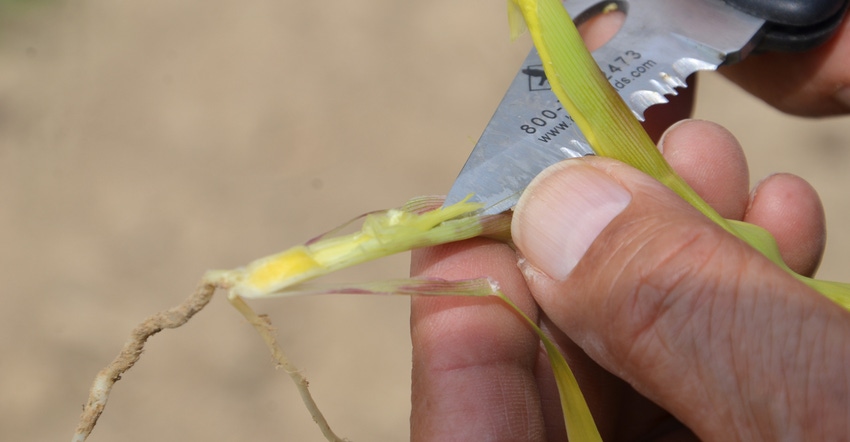
Dave Nanda loves to dig up a three- or four-leaf corn plant and demonstrate how to find the growing point. It’s part science, part art. He knows where the growing point is because he understands how the corn plant develops. Finding it, however, involves carefully peeling back tissue beneath leaves and sometimes delicately splitting the stem with a pocketknife to reveal the parts inside the young stem.
“The plant knows it must protect the growing point to survive,” says Nanda, director of genetics for Seed Genetics Direct. “Mother Nature protects it by keeping it underground until about the V5, or fifth-leaf stage. “If you get flooding, a frost or freeze, or hail, and the growing point is still underground, the plant can regrow.”
The only exception might be a freeze or hailstorm that causes so much tissue death and entanglement that the growing point can’t find its way through the maze of dead tissue. That happened to some plants in the freak frost event that occurred in the early 1990s in west-central and north-central Indiana, caused by a temperature inversion in early June.
Jumps ahead
A few months ago, Nanda discussed in his Corn Illustrated column that while the growing point starts out underground, below other leaf tissue as the first four to five leaves appear above ground, it then “jumps ahead” to the top of the plant. Once above ground, it rides its way to the top all the way to tasseling.
Once corn is knee-high or taller, the biggest threat is often hail. If a hailstorm simply shreds leaves, the plant can regrow, and yield loss may be less than you would first imagine. For example, the Purdue University Corn & Soybean Field Guide, 2021 edition, notes that even if 50% of the leaves are destroyed at the 12-leaf stage, the yield loss will likely only be about 9%, or 18 bushels per acre if the original potential was 200 bushels per acre. If that same storm hit at V7, with seven leaves with collars and the growing point above the ground, the potential loss, according to the guide, is only 2% for 50% defoliation, or 4 bushels per acre if the original potential was 200 bushels.
However, if corn is tasseling and 50% of leaves are destroyed, loss becomes significant, at 31%. By contrast, a hailstorm in the late-dent stage will only knock yields about 5%.
The real kicker in all these examples is leaf damage and not stalk bruising or damage to the growing point. If the growing point is so severely damaged it can’t recover, the plant likely won’t survive. Loss would be complete. It takes an intense, severe storm to cause that type of damage.
Nanda believes it’s important to understand how corn develops, and to know how and where to find the growing point at various stages of development. “If you know how the plant develops, you can better gauge how any type of injury along the way might impact potential corn yields,” he concludes.
About the Author(s)
You May Also Like




